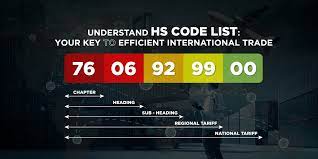Overview of HS Codes:
The Harmonized System (HS) is an internationally standardized system developed by the World Customs Organization (WCO) to classify goods for customs, trade, and statistical purposes. Each product is assigned a unique HS code, consisting of six to ten digits, providing a systematic classification of products traded globally.
Business Cards and HS Code Classification
HS Code for Business Cards: The HS code for business cards typically falls under Chapter 49 of the HS code classification, specifically within the subheading 4909.00.00.
Description: Subheading 4909.00.00 covers printed or illustrated postcards, greeting cards, and similar printed matter, including business cards. It encompasses cards typically used for correspondence, advertising, or announcements, made of paper or cardboard.

HS Code Classification Significance
International Trade and Customs: HS codes play a crucial role in international trade, facilitating the smooth flow of goods across borders by standardizing product categorization and documentation.
Customs Clearance: Proper classification of goods using HS codes is essential for customs clearance, ensuring compliance with regulations, and determining applicable duties and tariffs.
Statistical Analysis: HS codes aid in compiling trade statistics at both national and international levels, offering insights into global trade patterns and trends.
Business Cards and Import/Export Transactions
Export Procedures: When exporting business cards, assigning the correct HS code (4909.00.00) is crucial for accurately documenting the goods in export declarations and complying with export regulations.
Import Procedures: Importers must correctly classify business cards under the appropriate HS code during customs clearance to ensure compliance with import regulations and determine applicable duties.
HS Code Application Challenges and Considerations
Variations in Materials: Business cards can vary in materials used, such as paper type, thickness, or coatings, which might impact classification under the HS code.
Customs Classification Disputes: Interpretation of HS codes can sometimes lead to disputes between importers/exporters and customs authorities, necessitating clear documentation and proper classification justification.
Navigating International Trade Regulations
HS Code Verification: Importers/exporters should verify the correct HS code for business cards with customs authorities or utilize professional advice to ensure accurate classification.
Compliance Requirements: Understanding and complying with HS code regulations is essential for smooth international trade operations, avoiding delays or penalties due to misclassification.
Chapter 49: Paper and Paperboard; Articles of Paper Pulp, of Paper or Paperboard
Chapter 49 of the HS code encompasses various paper-related products, including printed matter like newspapers, books, brochures, and similar items.

Subheading 4909.00.00: Printed or Illustrated Postcards; Greeting Cards, and Similar Printed Matter, Including Business Cards
Subheading 4909.00.00 specifically addresses a range of printed materials designed for communication purposes, including business cards. This classification covers cards used for networking, marketing, or informational exchange in a professional context.
Customs Declarations and Documentation
Accuracy in assigning the HS code for business cards is crucial in customs declarations. Proper documentation with the correct code facilitates the smooth movement of goods across borders.
The HS code ensures uniformity in trade documentation, helping customs authorities identify and assess the nature of the goods being imported or exported.
Tariffs, Duties, and Trade Regulations
HS codes play a pivotal role in determining applicable tariffs, duties, and taxes levied on imported or exported goods. The assigned code dictates the tariff rates based on the classification.
Compliance with trade regulations, including product-specific standards and restrictions, is essential. Proper classification under the HS code ensures adherence to these regulations.
Challenges and Considerations in HS Code Application for Business Cards
Material Variations and Classification Complexity
Business cards come in various materials, sizes, and finishes, posing challenges in classifying them accurately under a single HS code. Variations in materials might impact their classification.
The complexity arises when cards are made of unconventional materials or feature intricate designs, as this might affect their classification.
Customs Compliance and Disputes
Disputes can arise between importers/exporters and customs authorities regarding the classification of business cards, particularly if there are uncertainties or disagreements in the interpretation of the HS code.
Clear documentation and supporting evidence justifying the assigned HS code are crucial in resolving classification disputes.
Adherence to HS Code Regulations for Business Cards
Expert Verification and Compliance
Importers/exporters often seek guidance from trade professionals or customs authorities to ensure accurate HS code assignment for business cards.
Employing experts in trade compliance or customs regulations aids in navigating the complexities of HS code classification.
Trade Facilitation and Global Market Access
Accurate HS code classification for business cards streamlines international trade operations, reducing delays at customs and ensuring compliance with trade laws, thereby facilitating global market access.
Conclusion
The HS code classification (4909.00.00) for business cards under Chapter 49 of the HS system holds significant importance in international trade. Accurate classification supports customs procedures, determines tariff rates, and ensures compliance with trade regulations. Businesses engaging in global trade must meticulously assign the appropriate HS code to business cards to navigate customs clearance and trade regulations effectively.
The proper application of the HS code for business cards is critical for businesses involved in international trade. Accurate classification ensures compliance, facilitates trade transactions, and mitigates challenges related to customs procedures and regulatory compliance.


You must be logged in to post a comment.